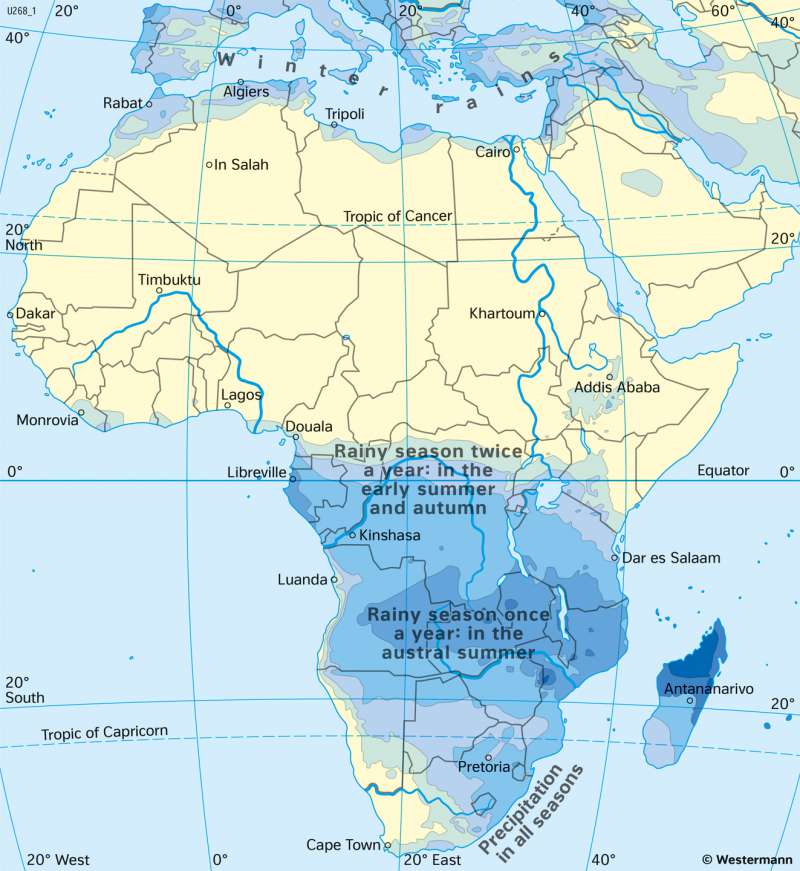Africa - Precipitation in January
Climate and Nile catchment
978-3-14-100890-6 | Page 147 | Ill. 5

Overview
The rhythm of life in Africa is shaped by the rainy and dry seasons. This is because the amount and seasonal distribution of rainfall are crucial for plant growth.
Climate regions
Only the central Congo Basin, the region around the mouth of the Niger River and eastern Madagascar, has year-round precipitation. With annual rainfall of more than 2000 millimetres, they are tropical regions with double rainy seasons in early summer and autumn - a humid climate prevails all year round. The precipitation is caused by the heavy cloud cover in the equatorial low pressure trough (ITCZ) that runs along the equator. South and north of the ever-humid tropics join the regions with winter drought. In January, therefore, less than 25 mm of precipitation falls in northern Africa, where it is now winter. In southern Africa, on the other hand, where it is summer in January, the rainy season prevails. The rainy season lasts a maximum of six months, and the monthly rainfall exceeds 200 mm, in some regions even 400 mm. In the area of the tropics, one finds fully arid regions, i.e. dry all year round. With up to twelve arid (dry) months and annual precipitation of less than 250 millimetres, sand, and rock deserts form. The core areas of these arid regions lie both outside the sphere of influence of the ITC and outside the westerly wind zone, which brings winter precipitation to the northern (Mediterranean) coast of Africa.
Regional climates
On the west coast of South Africa, aridity is intensified by the cold waters of the Benguela Current. The cold water cools the air over the sea. The cold air layer is overlaid by sinking, warm-dry air masses. This leads to a so-called temperature inversion. This means that a sudden temperature inversion occurs at the dividing line between the cold sea air and the warm air above. This temperature inversion is so stable that no convection, as would be necessary for the formation of rain clouds, can take place. Convection is the cooling of the air as it rises to higher altitudes. In the process, clouds form from the water vapour contained in the air. However, dense fog forms at the lower limit of the inversion. For the animals and plants of the Namib coastal desert, this fog wetness is the most important source of moisture. In south-east Africa, humid air masses come in from the Indian Ocean almost all year round. On the east coast and in Madagascar, these lead to considerable precipitation. The Horn of Africa is a semi-desert. This dryness has two main causes: During the winter months of December to February, the region lies in the sphere of influence of the northeast trade wind (tropical wind system with main wind direction from the northeast). This brings dry air masses from the Arabian Peninsula. In the summer months of June to August, however, the southwest monsoon over the Persian Gulf and India influences the Horn of Africa. However, as the region lies in a leeward position, i.e. in the lee of mountains, it only rains on the other side of the mountains, but not there.
Regional climates
On the west coast of South Africa, aridity is intensified by the cold waters of the Benguela Current. The cold water cools the air over the sea. The cold air layer is overlaid by sinking, warm-dry air masses. This leads to a so-called temperature inversion. This means that a sudden temperature inversion occurs at the dividing line between the cold sea air and the warm air above. This temperature inversion is so stable that no convection, as would be necessary for the formation of rain clouds, can take place. Convection is the cooling of the air as it rises to higher altitudes. In the process, clouds form from the water vapour contained in the air. However, dense fog forms at the lower limit of the inversion. For the animals and plants of the Namib coastal desert, this fog wetness is the most important source of moisture. In south-east Africa, humid air masses come in from the Indian Ocean almost all year round. On the east coast and in Madagascar, these lead to considerable precipitation. The Horn of Africa is a semi-desert. This dryness has two main causes: During the winter months of December to February, the region lies in the sphere of influence of the northeast trade wind (tropical wind system with main wind direction from the northeast). This brings dry air masses from the Arabian Peninsula. In the summer months of June to August, however, the southwest monsoon over the Persian Gulf and India influences the Horn of Africa. However, as the region lies in a leeward position, i.e. in the lee of mountains, it only rains on the other side of the mountains, but not there.




